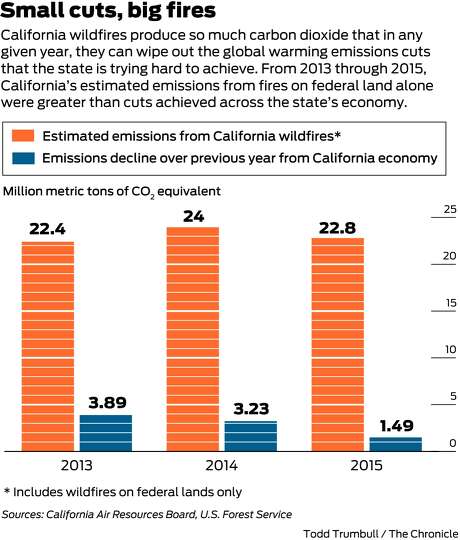https://www.sfchronicle.com/bayarea/article/Huge-wildfires-can-wipe-out-California-s-12376324.php

Most years, the amount of greenhouse gases spewed by California’s cars, factories and power plants drops slightly — a hard-won result of the state’s fight against global warming.
And in any given year, one big wildfire can wipe out that progress.
Over the course of just a few weeks, a major fire can pump more carbon dioxide into the atmosphere than California’s many climate change programs can save in 12 months. Scientists debate whether California’s vast forests are emitting more carbon dioxide through fires than they absorb through plant growth.
As global warming raises temperatures, making fires like the ones that tore through the Wine Country last month more likely, it could turn into a vicious cycle.
“That’s the reality, as painful and ugly as it may be,” said Jim Branham, executive officer of the Sierra Nevada Conservancy, a state agency charged with protecting the ecological and economic health of the Sierra region. “The sooner we get people looking at that reality, the sooner we can address it.”
To get a sense of the problem, look at 2015.
Greenhouse gas emissions across the California economy inched downward by 1.5 million metric tons that year, the most recent for which emissions data are available. And just one fire in 2015 — the Rough Fire, in the foothills of Fresno County — produced 6.8 million metric tons of greenhouse gases, according to an estimate from the U.S. Forest Service.
Other fires that year on federally managed land within California emitted 16 million metric tons.
And 2015 was not an isolated case. In 2013, for example, the state’s economy cut 3.89 million metric tons of emissions, while wildfires produced as many as 22.4 million metric tons, according to the Forest Service. The Rim Fire alone, started near Yosemite National Park that August by a runaway campfire, emitted between 10 million and 15 million metric tons.
The Rim Fire burned 257,314 acres of forest. For comparison, this year’s Wine Country fires together burned about 210,000 acres of forest, grassland, vineyards and urban neighborhoods.
The huge scale of the fire emissions calls into question the ability of California to meet its climate change goal of slashing greenhouse gas emissions 40 percent by 2030.

The state agency that oversees most of California’s global warming programs — the California Air Resources Board — does not include wildfires in its annual inventory of emissions, the official scorecard of the state’s progress on global warming. When state officials talk about how much California has managed to cut its emissions so far, they don’t factor in wildfires.
That could change. The board has spent much of the last decade researching how to calculate and track wildfire emissions and is working on a year-by-year tally.
“There’s a lot of uncertainties in quantifying this,” said Dave Edwards, chief of the board’s greenhouse gas inventory branch. “It’s not like power plants burning fossil fuels.”
Not all fires, after all, will produce the same amount of carbon dioxide for each acre that burns. Far less carbon is stored in the plants found on an acre of open grassland than on an acre of redwood forest, whose massive trees have been absorbing CO2 for centuries and using it to grow wood.
In climate policy, forests are usually seen as one of the only available tools for extracting carbon dioxide — the most common greenhouse gas — from the atmosphere at a significant scale.
And yet large, severe fires have become so common in California that scientists debate whether the state’s forests have turned into net producers of carbon dioxide, rather than carbon sinks. The balance could tip from one to the other over time, said Dick Cameron, director of science for California land programs at the Nature Conservancy environmental organization.
“We can go from carbon sink to source in a five- to 10-year period,” he said.
One study commissioned by the Air Resources Board estimated that from 2001 through 2010, the amount of carbon stored in California’s natural and working lands decreased by 150 million metric tons, with 80 percent of those losses coming from wildfires.
With at least 43 people killed by this year’s Wine Country fires and thousands more lives upended, the emissions that fires produce may seem a distant, abstract problem. But measures to prevent those emissions may also help prevent wildfire deaths.
Those measures include careful management of California’s forests by removing dead or smaller trees that have been allowed to proliferate through decades of fire-suppression policies. That can be done through targeted logging or by small, intentionally set fires during times when weather conditions aren’t likely to spread them out of control — as is already done in many forests around the state.
“We just have way too much fuel in our forested landscapes,” Branham said. “The forests of today do not at all look like the forests John Muir would write about.”
